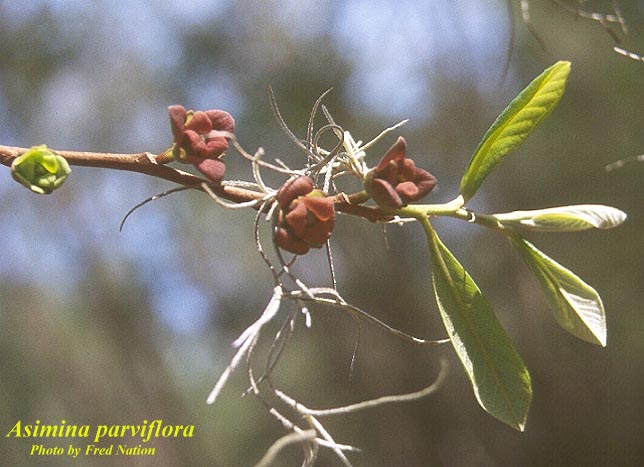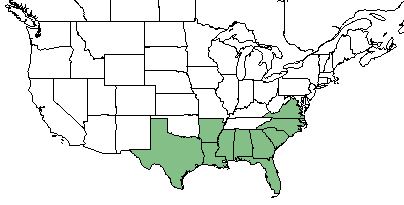Difference between revisions of "Asimina parviflora"
(→Distribution) |
(→Ecology) |
||
| Line 30: | Line 30: | ||
==Ecology== | ==Ecology== | ||
| − | ===Habitat=== <!--Natural communities, human disturbed habitats, topography, hydrology, soils, light, fire regime requirements for removal of competition, etc.--> | + | ===Habitat=== |
| − | + | ''A. parviflora'' is a deciduous shrub found in the Coastal Plain in the southeastern United States. <ref name= "Norman 1992"> [Norman, E. M., et al. (1992). "Reproductive Biology of Asimina parviflora (Annonaceae)." Bulletin of the Torrey Botanical Club 119(1): 1-6.]</ref> | |
| − | + | ||
| − | + | <!--Natural communities, human disturbed habitats, topography, hydrology, soils, light, fire regime requirements for removal of competition, etc.--> | |
| + | ===Phenology=== | ||
| + | The ''A. parviflora'' flowers are the smallest in the ''assimina'' genus with 4-6 maroon flowers per branch. The flowers are in bloom from February to May depending on the year. <ref name= "Norman 1992"/> | ||
| + | |||
| + | <!--Timing off flowering, fruiting, seed dispersal, and environmental triggers. Cite PanFlora website if appropriate: http://www.gilnelson.com/PanFlora/ --> | ||
| + | ===Seed dispersal=== | ||
| + | The ''A. parviflora'' is pollinated by insects including the greenbottle fly and nitidulid beetles.<ref name= "Norman 1992"/> | ||
| + | |||
| + | ===Seed bank and germination=== | ||
| + | The fruit from ''A. parviflora'' requires an average of 3-4 months to mature and the number of seeds germinated is low compared to the initial population developed. <ref name= "Norman 1992"/> | ||
<!--===Fire ecology===--> <!--Fire tolerance, fire dependence, adaptive fire responses--> | <!--===Fire ecology===--> <!--Fire tolerance, fire dependence, adaptive fire responses--> | ||
<!--===Pollination===--> | <!--===Pollination===--> | ||
| − | + | ===Use by animals=== | |
| + | A variety of flies are the most common visitor to the ''A. parviflora'' but they have not been traced to pollination, which is largely a result from beetles and the greenbottle fly.<ref name= "Norman 1992"/> | ||
| + | <!--Herbivory, granivory, insect hosting, etc.--> | ||
<!--==Diseases and parasites==--> | <!--==Diseases and parasites==--> | ||
Revision as of 18:38, 16 May 2018
| Asimina parviflora | |
|---|---|

| |
| Photo by the Atlas of Florida Plants Database | |
| Scientific classification | |
| Kingdom: | Plantae |
| Division: | Magnoliophyta - Flowering plants |
| Class: | Magnoliopsida - Dicots |
| Order: | Magnoliales |
| Family: | Annonaceae |
| Genus: | Asimina |
| Species: | A. parviflora |
| Binomial name | |
| Asimina parviflora (Michx.) Dunal | |

| |
| Natural range of Asimina parviflora from USDA NRCS Plants Database. | |
Contents
Taxonomic Notes
Synonyms: none
Varieties: none
Description
A. parviflora is a perennial shrub tree of hte Annonaceae family native to the southeastern United States. [1]
Distribution
A. parviflora is found in the southeastern United States, particularly in Florida, Georgia, South Carolina, North Carolina, Alabama, Mississippi, Louisiana, Arkansas, and Texas. [1]
Ecology
Habitat
A. parviflora is a deciduous shrub found in the Coastal Plain in the southeastern United States. [2]
Phenology
The A. parviflora flowers are the smallest in the assimina genus with 4-6 maroon flowers per branch. The flowers are in bloom from February to May depending on the year. [2]
Seed dispersal
The A. parviflora is pollinated by insects including the greenbottle fly and nitidulid beetles.[2]
Seed bank and germination
The fruit from A. parviflora requires an average of 3-4 months to mature and the number of seeds germinated is low compared to the initial population developed. [2]
Use by animals
A variety of flies are the most common visitor to the A. parviflora but they have not been traced to pollination, which is largely a result from beetles and the greenbottle fly.[2]